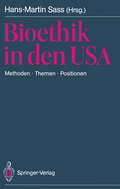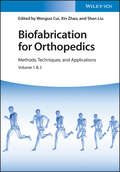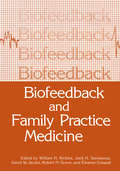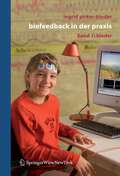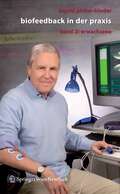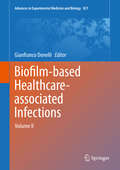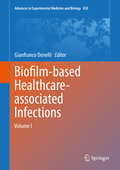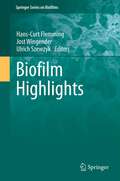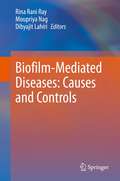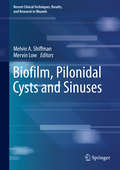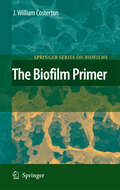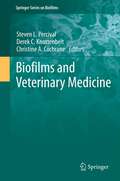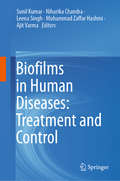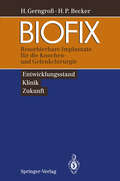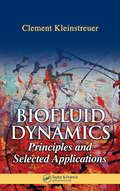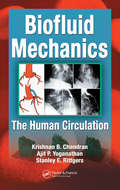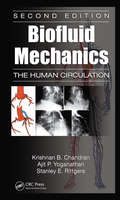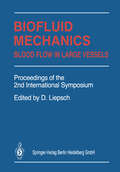- Table View
- List View
Bioethik in den USA: Methoden · Themen · Positionen. Mit besonderer Berücksichtigung der Problemstellungen in der BRD
by R.M. Cook-Deegan H. T. Engelhardt R. Faden T. Pinkard H. M. Sass R. M. Veatch L. WaltersBiofabrication for Orthopedics: Methods, Techniques and Applications
by Wenguo Cui Xin Zhao Shen LiuBiofabrication for Orthopedics A comprehensive overview of biofabrication techniques for orthopedics and their novel applications With an ever-increasing global population and the rise in the occurrence of orthopedic diseases amongst an aging population, it is essential for technological advances to meet this growing medical need. Orthopedic biofabrication is a cutting-edge field that seeks to produce novel clinical solutions to this mounting problem, through the incorporation of revolutionary technologies that have the potential to not only transform healthcare, but also provide highly automated and personalized patient solutions. With the advances in the discipline, there is a significant growing interest in biofabrication for orthopedics in research activity geared towards routine clinical use. Ideal for a broad readership amongst medical practitioners and scientists, Biofabrication for Orthopedics summarizes all aspects of the topic: detailed information on the technology, along with advanced developments, research progress, and future perspectives on biofabrication for orthopaedics—particularly on the potential applications for tissue engineering technologies. In doing so, the book describes the various biomaterials—natural and synthetic—use for orthopedics and discusses the many ways in which these materials can be used in all parts of the body. As such, it offers detailed information on a wide range of applications in the fields of biology and clinical and industrial manufacturing. Biofabrication for Orthopedics readers will also find: Insights into the applications of biofabrication technologies in various bodily functions Thorough discussion of different biofabrication techniques used in creating orthopedic products, like stereolithography, cell sheet and organ bioprinting, electrospinning, and microfluidics Discussion of a wide range of diverse functions, such as bone implants, skin regeneration, vascularization, meniscus remodeling, and more Biofabrication for Orthopedics is a useful reference for those in a variety of research fields like medical-related practitioners and scientists, materials science, medicine, and manufacturing, as well as the libraries who support them.
Biofabrication for Orthopedics: Methods, Techniques and Applications
by Wenguo Cui Xin Zhao Shen LiuBiofabrication for Orthopedics A comprehensive overview of biofabrication techniques for orthopedics and their novel applications With an ever-increasing global population and the rise in the occurrence of orthopedic diseases amongst an aging population, it is essential for technological advances to meet this growing medical need. Orthopedic biofabrication is a cutting-edge field that seeks to produce novel clinical solutions to this mounting problem, through the incorporation of revolutionary technologies that have the potential to not only transform healthcare, but also provide highly automated and personalized patient solutions. With the advances in the discipline, there is a significant growing interest in biofabrication for orthopedics in research activity geared towards routine clinical use. Ideal for a broad readership amongst medical practitioners and scientists, Biofabrication for Orthopedics summarizes all aspects of the topic: detailed information on the technology, along with advanced developments, research progress, and future perspectives on biofabrication for orthopaedics—particularly on the potential applications for tissue engineering technologies. In doing so, the book describes the various biomaterials—natural and synthetic—use for orthopedics and discusses the many ways in which these materials can be used in all parts of the body. As such, it offers detailed information on a wide range of applications in the fields of biology and clinical and industrial manufacturing. Biofabrication for Orthopedics readers will also find: Insights into the applications of biofabrication technologies in various bodily functions Thorough discussion of different biofabrication techniques used in creating orthopedic products, like stereolithography, cell sheet and organ bioprinting, electrospinning, and microfluidics Discussion of a wide range of diverse functions, such as bone implants, skin regeneration, vascularization, meniscus remodeling, and more Biofabrication for Orthopedics is a useful reference for those in a variety of research fields like medical-related practitioners and scientists, materials science, medicine, and manufacturing, as well as the libraries who support them.
Biofeedback and Family Practice Medicine
by EleanorCriswell Robert N. Grove David W. Jacobs Jack H. Sandweiss William H. RicklesDuring the past five years there has been a reawakening of interest in the psychotherapy of patients with medical disorders characterized as psychosomatic. For three decades, psychoanalysis and psychoanalytic psychotherapy were used extensively to treat and study psychosomatic disorders. Early in the 1960s, interest in this approach to these conditions faded, and the ·Psychosomatic Service· in most hospitals became the ·Consultation Liaison Service· (Lipowski, 1967). The recent focus of biofeedback on psychosomatic conditions provides a new technique with which the physician or psychiatrist may treat these patients (Rickles, 1981). In addition, the successful application of biofeedback training to a variety of complaints such as those presented in this volume has heralded the addition of biofeedback to the treatment modalities used for medical complaints. Frequently, psychological factors can still be seen; for example, when biofeedback treatment may require lifestyle changes on the part of the patient, the exploration of secondary gains or resistances before the disorder can be success fully treated, and the establishment of rapport and empathy which is so important for truly effective biofeedback training. Aside from certain psychological dimensions that are always present in biofeed back training, in this case biofeedback is being used in a primarily medical setting for primarily medical complaints.
Biofeedback in der Praxis: Band 1: Kinder
by Ingrid Pirker-BinderGefühle wie Stress, Angst oder Freude verändern Herzrate, Atmung, Muskelspannung, Fingertemperatur und Hautleitwert. Biofeedback zeigt dies und fördert so die Selbstwahrnehmung und das Verständnis eigener Reaktionen. Kinder erlernen die Methode sehr schnell. Erstmalig bespricht dieses Buch wie sie auf Kinder angewendet werden kann. So z.B. beim Stressmanagement in Kindergarten oder Schule, bei Traumatisierungen, ADHD, ADD und in der Psychosomatik. Schritt für Schritt erklärt: das Therapiekonzept ASTI® für multimodales Biofeedback. Mit zahlreichen Übungsgeschichten: ein gelungenes Praxisbuch für Therapeuten, Trainer, Ärzte, Lehrer und Eltern.
Biofeedback in der Praxis: Band 2: Erwachsene
by Ingrid Pirker-BinderBiofeedback zeigt, wie der menschliche Körper auf Stress, Angst oder Freude durch die Veränderung der Herzschlagrate, Atmung, Muskelspannung, Fingertemperatur oder des Hautleitwertes reagiert. Praxisnah und anhand von Fallbeispielen veranschaulicht eine erfahrene Biofeedback-Spezialistin dessen Anwendung zur Erhaltung der Leistungsfähigkeit: im Sport, bei hoher Stressbelastung und "Zivilisationskrankheiten" (z.B. Bluthochdruck, Muskelverspannung, Panik, Migräne) sowie bei frauenspezifischen Themen (z.B. Menopause, Geburt, Beckenbodentraining). Therapeuten, Trainer, Ärzte und Interessierte profitieren von ihrem umfangreichen Erfahrungsschatz.
Biofilm-based Healthcare-associated Infections: Volume II (Advances in Experimental Medicine and Biology #831)
by Gianfranco DonelliThe aim of this book is to provide readers with a wide overview of the main healthcare-associated infections caused by bacteria and fungi able to grow as biofilm. The recently acquired knowledge on the pivotal role played by biofilm-growing microorganisms in healthcare-related infections has given a new dynamic to detection, prevention and treatment of these infections in patients admitted to both acute care hospitals and long-term care facilities. Clinicians, hygienists and microbiologists will be updated by leading scientists on the state-of-art of biofilm-based infections and on the most innovative strategies for prevention and treatment of these infections, often caused by emerging multidrug-resistant biofilm-growing microorganisms.
Biofilm-based Healthcare-associated Infections: Volume I (Advances in Experimental Medicine and Biology #830)
by Gianfranco DonelliThe aim of this book is to provide readers with a wide overview of the main healthcare-associated infections caused by bacteria and fungi able to grow as biofilm. The recently acquired knowledge on the pivotal role played by biofilm-growing microorganisms in healthcare-related infections has given a new dynamic to detection, prevention and treatment of these infections in patients admitted to both acute care hospitals and long-term care facilities. Clinicians, hygienists and microbiologists will be updated by leading scientists on the state-of-art of biofilm-based infections and on the most innovative strategies for prevention and treatment of these infections, often caused by emerging multidrug-resistant biofilm-growing microorganisms.
Biofilm Highlights (Springer Series on Biofilms #5)
by Hans-Curt Flemming, Jost Wingender and Ulrich SzewzykLiving in biofilms is the common way of life of microorganisms, transiently immobilized in their matrix of extracellular polymeric substances (EPS), interacting in many ways and using the matrix as an external digestion and protection system. This is how they have organized their life in the environment, in the medical context and in technical systems – and has helped make them the oldest, most successful and ubiquitous form of life. In this book, hot spots in current biofilm research are presented in critical and sometimes provocative chapters. This serves a twofold purpose: to provide an overview and to inspire further discussions. Above all, the book seeks to stimulate lateral thinking.
Biofilm-Mediated Diseases: Causes and Controls
by Rina Rani Ray Moupriya Nag Dibyajit LahiriThis book reviews the current concepts in biofilm formation and its implications in human health and disease. The initial chapters introduce the mechanisms of biofilm formation and its composition. Subsequently, the chapters discuss the role of biofilm in acute and chronic infections. It also explores the pivotal role of both innate and adaptive immunity on the course of biofilm infection. In addition, the book elucidates the bacterial biofilm formation on implantable devices and the current approaches to its treatment and prevention. It analyzes the possible relationship between antimicrobial resistance and biofilm formation. Finally, the book also summarizes the current state-of-the-art therapeutic approaches for preventing and treating biofilms. This book is a useful resource for researchers in the field of microbiology, clinical microbiology, and also medical practitioners.
Biofilm, Pilonidal Cysts and Sinuses (Recent Clinical Techniques, Results, and Research in Wounds #1)
by Melvin A. Shiffman Mervin LowThis book discusses the latest findings in the fields of biofilm, pilonidal cysts and sinuses. The first part provides detailed information on biofilm formation, antibiofilm properties and activity as well as their potential clinical application in wound management. The second part then examines pilonidal sinus disease and the surgical treatment options. Written by leading experts in the field, the book is a valuable resource for beginners and experienced surgeons alike.
The Biofilm Primer (Springer Series on Biofilms #1)
by J. William CostertonThis book details the widely accepted hypothesis that the majority of bacteria in virtually all ecosystems grow in matrix-enclosed biofilms. The author, who first proposed this biofilm hypothesis, uses direct evidence from microscopy and from molecular techniques, arguing cogently for moving beyond conventional culture methods that dominated microbiology in the last century. Bacteria grow predominantly in biofilms in natural, engineered, and pathogenic ecosystems; this book provides a solid basis for the understanding of bacterial processes in environmental, industrial, agricultural, dental and medical microbiology. Using a unique "ecological" perspective, the author explores the commensal and pathogenic colonization of human organ systems.
Biofilms and Veterinary Medicine (Springer Series on Biofilms #6)
by Steven Percival, Derek Knottenbelt and Christine CochraneBiofilms are implicated in many common medical problems including urinary tract infections, catheter infections, middle-ear infections, dental plaque, gingivitis, and some less common but more lethal processes such as endocarditis and infections in cystic fibrosis. However, the true importance of biofilms in the overall process of disease pathogenesis has only recently been recognized. Bacterial biofilms are one of the fundamental reasons for incipient wound healing failure in that they may impair natural cutaneous wound healing and reduce topical antimicrobial efficiency in infected skin wounds. Their existence explains many of the enigmas of microbial infection and a better grasp of the process may well serve to establish a different approach to infection control and management. Biofilms and their associated complications have been found to be involved in up to 80% of all infections. A large number of studies targeted at the bacterial biofilms have been conducted, and many of them are referred to in this book, which is the first of its kind. These clinical observations emphasize the importance of biofilm formation to both superficial and systemic infections, and the inability of current antimicrobial therapies to ‘cure’ the resulting diseases even when the in vitro tests suggest that they should be fully effective.In veterinary medicine the concept of biofilms and their role in the pathogenesis of disease has lagged seriously behind that in human medicine. This is all the more extraordinary when one considers that much of the research has been carried out using veterinary species in experimental situations. The clinical features of biofilms in human medicine is certainly mimicked in the veterinary species but there is an inherent and highly regrettable indifference to the failure of antimicrobial therapy in many veterinary disease situations, and this is probably at its most retrograde in veterinary wound management. Biofilms and Veterinary Medicine is specifically focused on discussing the concerns of biofilms to health and disease in animals and provides a definitive text for veterinary practitioners, medical and veterinary students, and researchers.
Biofilms in Human Diseases: Treatment and Control
by Sunil Kumar Niharika Chandra Leena Singh Muhammad Zaffar Hashmi Ajit VarmaThis book highlights treatment strategies for bacterial biofilms in connection with a variety of human diseases. In particular, it reviews bacterial biofilm formation and its mechanism. Topics covered include biofilms in human health, the role of biofilms in mediating human diseases, and methods for testing bacterial biofilms. Further sections concentrate on biofilm-mediated diseases in different parts of the human gastrointestinal tract, while therapeutic strategies for biofilm control and natural agents that disrupt bacterial biofilms are also covered. Readers will also find the latest advances in probiotics and biofilms, as well as the use of probiotics to counteract biofilm-associated infections. Biofilms and antimicrobial resistance are discussed. Subsequent chapters address the management of inflammatory bowel disease via probiotics biofilms, as well as the role of probiotics bacteria in the treatment of human diseases associated with bacterial biofilms. The book is chiefly intended for clinicians/scientists in the fields of medical microbiology, applied microbiology, biochemistry, and biotechnology.
BIOFIX: Resorbierbare Implantate für die Knochen- und Gelenkchirurgie — Entwicklungsstand, Klinik, Zukunft —
by Heinz Gerngroß Horst P. BeckerBiofluid Dynamics: Principles and Selected Applications
by Clement KleinstreuerRequiring only an introductory background in continuum mechanics, including thermodynamics, fluid mechanics, and solid mechanics, Biofluid Dynamics: Principles and Selected Applications contains review, methodology, and application chapters to build a solid understanding of medical implants and devices. For additional assistance, it includes a glos
Biofluid Mechanics: The Human Circulation
by Krishnan B. ChandranPart medicine, part biology, and part engineering, biomedicine and bioengineering are by their nature hybrid disciplines. To make these disciplines work, engineers need to speak "medicine," and clinicians and scientists need to speak "engineering." Building a bridge between these two worlds, Biofluid Mechanics: The Human Circulation integrates flui
Biofluid Mechanics: The Human Circulation, Second Edition
by Krishnan B. Chandran Stanley E. Rittgers Ajit P. YoganathanDesigned for senior undergraduate or first-year graduate students in biomedical engineering, Biofluid Mechanics: The Human Circulation, Second Edition teaches students how fluid mechanics is applied to the study of the human circulatory system. Reflecting changes in the field since the publication of its predecessor, this second edition has been ex
Biofluid Mechanics: The Human Circulation, Second Edition
by Krishnan B. Chandran Stanley E. Rittgers Ajit P. YoganathanDesigned for senior undergraduate or first-year graduate students in biomedical engineering, Biofluid Mechanics: The Human Circulation, Second Edition teaches students how fluid mechanics is applied to the study of the human circulatory system. Reflecting changes in the field since the publication of its predecessor, this second edition has been ex
Biofluid Mechanics: Blood Flow in Large Vessels
by Dieter W. LiepschProceedings of the 2nd International Symposium Biofluid Mechanics and Biorheology. June 25-28, 1989, Munich
Biofluid Mechanics · 2
by D. J. SchneckThe Department of Engineering Science and Hechanics at Virginia Polytechnic Institute and State University spon sored the First Mid-Atlantic Conference on Bio-Fluid Mechanics, which was held in Blacksburg, Virginia during the period 9-11 August 1978. Some 40 life-scientists, engineers, physicians and others who share a common interest in the advancement of basic and applied knowledge in bio fluid mechanics gathered at the Donaldson Brown Center for Continuing Education to hear 25 papers presented in seven technical sessions. At the conclusion of the conference, those present decided unanimously that its success warranted having at least one more -- and that it was conceptually a sound idea to plan it on a biennial basis for late spring. Hence, the second Mid-Atlantic Conference on Bio Fluid Mechanics took place at Virginia Tech on May 4-6, 1980. This volume documents the Proceedings of the second conference. It contains full texts of 23 contributed papers, 2 guest lectures and 1 invited seminar. The papers are gr9uped according to subject matter, beginning with 3 in the area of respiration, followed by 1 in kidney dialysis, 1 in reproduction, 1 in joint lubrication, 1 in prosthetic fluidics, 2 in zoology, and ending with 14 in the general field of cardiovascular dynamics. Of the latter, 5 deal with the subject of heart valves, 2 concern themselves with the microcirculation, 6 address vascular system hemodynamics and 1 covers some aspects of blood rheology.
Biofluidmechanik: Grundlagen und Anwendungen
by Dieter LiepschDieses Buch führt Sie in die Grundlagen der Biofluidmechanik einWie funktioniert der menschliche Blutkreislauf? Wie arbeiten Mikrozirkulationsvorgänge? Mit diesen und vielen weiteren Fragen der Strömungsuntersuchung beschäftigt sich die Biofluidmechanik. Dieses Buch gewährt ihnen interessante Einblicke in die Grundlagen der Biofluidmechanik.Die Biofluidmechanik ist eine thematisch sehr breit gestaffelte Wissenschaft. Sie erforscht die Gesetzmäßigkeiten der Bewegung, des Kräftegleichgewichtes und der Strömungstechnik von Fluiden. Hierzu gehören unter anderem:• Atmung• Blutkreislauf• Mikrozirkulationsvorgänge• Lymphströmungen• Künstliche Gefäßersatze• Gefäßprothesen aus verschiedenen Materialien• Künstliche Herzklappen• Urologische Messungen• Künstliche Harnleiter• Blutrheologie• Transport durch Membranen• Bewegung geladener Partikel• Ionen in Lösungen• Vibrationen• Wellenfortpflanzung und SchockwellenWichtiges Grundlagenwissen der Biofluidmechanik in einem Buch In seinem Buch gibt der Autor einen ausführlichen Überblick über die Grundlagen der Biofluidmechanik und stellt die folgenden Themen detailliert vor:• Einleitung in die Biofluidmechanik• Physikalische Grundlagen von Fluiden• Rheologische Grundlagen• Biofluide (Körperflüssigkeiten) in Menschen und Tieren• Grundlegende theoretische Fluid- bzw. hämodynamische Betrachtungen• Medizinische Grundlagen, menschliches Kreislaufsystem, Blutgefäße, Herz, Lungenmechanik und Atmung• Besonderheiten und Messmethoden der Biofluidmechanik• Anwendungen und Beispiele in Modellen, diagnostische und therapeutische BedeutungAufgrund des hohen Praxisbezugs ist dieses Buch über die Biofluidmechanik nicht nur für Studenten, sondern auch für Beschäftigte in Gesundheitsforschung und Medizin ein wichtiges und hilfreiches Grundlagenwerk.
Biofluids Modeling: Methods, Perspectives, and Solutions
by Wilson C. Chin Jamie A. ChinBIOFLUIDS MODELING The first book offering analytical and modern computational solutions to important biofluids problems, such as non-Newtonian flows in blood vessels, clogged arteries and veins, bifurcated arteries and veins, arbitrary stent geometries, tissue properties prediction, and porous media Darcy flow simulation in large-scale organ analysis, this is a must-have for any library. This book introduces new methods for biofluids modeling and biological engineering. The foregoing subjects are treated rigorously, with all modeling assumptions stated and solutions clearly derived. But that’s not all. Key supporting physics-based ideas, algorithmic details, and software design interfaces are equally emphasized, in order to support our overriding objective of getting the anatomical and clinical information that physicians need. Importantly, this volume provides a self-contained exposition that includes all required biological concepts, plus the background preparation needed in fluid mechanics, basic differential equations, and modern numerical analysis. The presentation style will appeal to medical practitioners, researchers, biomedical engineers, and students interested in quantitative fluid flow modeling, as well as engineering students eager to learn about advances in a rapidly growing and changing biological science. As such, the book represents “must-reading” suitable at the advanced undergraduate level, and motivated readers should be able to embark on related research following guided study.
Biofluids Modeling: Methods, Perspectives, and Solutions
by Wilson Chin Jamie ChinBIOFLUIDS MODELING The first book offering analytical and modern computational solutions to important biofluids problems, such as non-Newtonian flows in blood vessels, clogged arteries and veins, bifurcated arteries and veins, arbitrary stent geometries, tissue properties prediction, and porous media Darcy flow simulation in large-scale organ analysis, this is a must-have for any library. This book introduces new methods for biofluids modeling and biological engineering. The foregoing subjects are treated rigorously, with all modeling assumptions stated and solutions clearly derived. But that’s not all. Key supporting physics-based ideas, algorithmic details, and software design interfaces are equally emphasized, in order to support our overriding objective of getting the anatomical and clinical information that physicians need. Importantly, this volume provides a self-contained exposition that includes all required biological concepts, plus the background preparation needed in fluid mechanics, basic differential equations, and modern numerical analysis. The presentation style will appeal to medical practitioners, researchers, biomedical engineers, and students interested in quantitative fluid flow modeling, as well as engineering students eager to learn about advances in a rapidly growing and changing biological science. As such, the book represents “must-reading” suitable at the advanced undergraduate level, and motivated readers should be able to embark on related research following guided study.
Biofortification of Food Crops
by Ummed Singh C S Praharaj S S Singh N P SinghThe chapters presented in this book ‘Biofortification of Food Crops’ depict how agricultural technological interventions have true role in alleviating malnutrition. This book highlights the role of multidisciplinary approaches to cope up with the challenges of micronutrient malnutrition or hidden hunger which is an alarming public health issue in most parts of the world including India. In this endeavour, different biofortification approaches such as agronomic (or ferti-fortification), breeding, biotechnological, physiological, microbial etc. has fulfilled their different mandates of nutrient enrichment of food crops including cereals and pulses. The contents of the book proves that biofortified plants have adequate potential to nourish nutrient depleted soils, help increase crop productivity and provide nutritional benefits to plants, humans and livestock. The content and quality of information presented in this book will definitely provide multiple novel ideas of advance techniques and will stimulate innovative thoughts and directions amongst researchers and policy makers in the field of biofortification. In addition, the contributions presented in the book will be a good source of background knowledge and technical know-how to educate the readers about biofortification. The authors hope that the book entitled “Biofortification of Food Crops” would provide a suitable platform in our collective efforts for an appropriate dialogue among the scientists, researchers, entrepreneurs, policy makers and farmers in reducing the budding issues of malnutrition through novel approaches and means.
